Community-Scale Rural Drinking Water Supply Systems Based on Harvested Rainwater: A Case Study of Australia and Vietnam
Abstract
:1. Introduction
2. Literature Review
3. Materials and Methods
3.1. Study Areas and Data Selection
3.2. Design of Community-Scale Drinking Water Supply System Based on Harvested Rainwater
- a.
- Rainwater collection apparatus
- b.
- Rainwater storage tank
- c.
- Multi-step rainwater treatment system
- d.
- Storage tank to hold daily produced drinking water
- e.
- Solar energy system and water pumps
3.3. Water Balance and Economic Analysis
3.3.1. Reliability Analysis
- Rural community sizes: due to different population sizes and densities between Australia and Vietnam, five scenarios of rural community with 50, 100, 150, 200 and 250 households were considered in the model.
- Household sizes: Vietnamese scenarios are based on household size of four people, rounded up from the average rural household size of 3.9 in the statistic of Vietnam Population and Housing Census survey [74]. However, three occupants per household is considered in Australian scenarios because households in Australia are getting smaller; the average number of people per household fell from 4.5 to 2.6 during 1911–2016 [75].
- Daily drinking water usage: In order to follow the UN requirements regarding the right to water, we selected drinking water demand in rural areas in the range of 20–50 L/capita/day (LCD). This range of drinking water demand for a person in a day can be sufficient for a range of activities (such as 10 L for drinking, 20 L for drinking and cooking, 30 L for drinking, cooking and personal washing, 40 L for drinking, cooking, personal washing and cloth washing, and 50 L for drinking, cooking, personal washing, cloth washing and cleaning home [76,77,78]). The study analysed multiple scenarios with 5 LCD intervals within the range of drinking water demand (i.e., 20, 25, 30, 35, 40, 45 and 50 LCD). As the study considered the rural areas with limited/no access to mains water supply, the analysis was performed to understand whether an RWH system could meet the drinking water demand for a rural community in the lowest expectation of emergencies and/or in the highest expectation of sustainable developments.
- Rainwater tank size: a wide range of tank sizes from 25–1600 kL was tested in the model to evaluate trends of reliability and the capacity of water supplied by the proposed RWH system.
- The runoff coefficient (C) is a dimensionless coefficient relating the amount of runoff to the amount of precipitation received. It depends on roof gradient and gutter characteristics. It is recommended that the C value for the roof is 0.75–0.95. The designers must determine the most appropriate C value within this range [79]; here we selected a typical value of 0.85.
- According to the guidance on the use of rainwater tanks by the Australian Government Department of Health, the average roof area can range from 100–150 m2 for a small house, 150–200 m2 for a medium house and greater than 200 m2 for a large house [80]. In this study, the average roof area for a medium house in the rural community is considered at 200 m2.
- First flush is the initial surface runoff from a rainfall event. There is considerable literature dedicated to the study of first flush phenomena. The classic study by Yaziz et al. (1989), with a number of experiments based on fixed volumes, described a rule-of-thumb of diverting 5 L of first flush [81]. Other publications have recommended first flush should be between 1–2 gallons per 100 square feet of roofing or 20–25 L for an average-sized roof [82]. Studies on quantifying the first flush phenomenon reported that for each 1 mm of first flush the contaminate load will halve. It is possible to remove up to 85% of incoming pollution material while retaining 85% of the roof harvested rainwater if the first flush device is designed carefully [83,84]. Moreover, other research showed that bypassing the first 2 mm of rainfall gives harvested rainwater the most quality parameters compliant with the Australian Drinking Water Guidelines [85]. In this study, it is assumed that the rural community can apply well-designed first flush devices, and the first 1 mm of rainfall in a rain event can be the robust average first flush loss value that was applied in the MATLAB model.
- Finally, modelling outputs for the proposed RWH system were calculated as follows.
- Number of consumers = number of houses x number of occupants per household.
- Water demand (WD) = number of consumers x daily drinking water usage per person.
- Runoff, effective runoff, overflow, water demand, water supply and track changes in storage volume from the rainwater tank can be simulated on a daily time step by the YAS algorithm (Equations (1)–(7)).
3.3.2. Life Cycle Cost Analysis (LCCA)
4. Results
4.1. Reliability
4.2. ADWP
4.3. BCR
4.4. Sensitivity Analysis for the Produced Water Price
5. Discussion
6. Conclusions
Supplementary Materials
Author Contributions
Funding
Data Availability Statement
Acknowledgments
Conflicts of Interest
References
- UNESCO. Rural Water Development. Available online: https://en.unesco.org/themes/water-security/hydrology/water-human-settlements/rural-development (accessed on 1 May 2022).
- Peters, C.N.; Baroud, H.; Hornberger, G.M. Multicriteria Decision Analysis of Drinking Water Source Selection in Southwestern Bangladesh. J. Water Resour. Plan. Manag. 2019, 145, 5019004. [Google Scholar] [CrossRef]
- Alataway, A.; El Alfy, M. Rainwater Harvesting and Artificial Groundwater Recharge in Arid Areas: Case Study in Wadi Al-Alb, Saudi Arabia. J. Water Resour. Plan. Manag. 2019, 145, 5018017. [Google Scholar] [CrossRef]
- Dallman, S.; Chaudhry, A.M.; Muleta, M.K.; Lee, J. Is Rainwater Harvesting Worthwhile? A Benefit–Cost Analysis. J. Water Resour. Plan. Manag. 2021, 147, 4021011. [Google Scholar] [CrossRef]
- Leonard, D.; Gato-Trinidad, S. Effect of Rainwater Harvesting on Residential Water Use: Empirical Case Study. J. Water Resour. Plan. Manag. 2021, 147, 4. [Google Scholar] [CrossRef]
- Semaan, M.; Day, S.D.; Gavin, M.; Ramakrishnan, N.; Pearce, A. Distributed Rainwater Harvesting: Novel Approach to Rainwater Harvesting Systems for Single-Family Households. J. Water Resour. Plan. Manag. 2021, 147, 4021061. [Google Scholar] [CrossRef]
- UNEP. Rainwater Harvesting: A Lifeline to Human Well-Being; Stockholm Environment Institute: Stockholm, Sweden, 2009. [Google Scholar]
- UN, 2015. Transforming Our World: The 2030 Agenda for Sustainable Development Resolution Adopted by the General Assembly on September 25, 2015, A/RES/70/1. United Nations General Assembly. Available online: https://sdgs.un.org/2030agenda (accessed on 1 May 2022).
- Gupta, R.K.; Agrawal, R.K. Rainwater harvesting in Ancient Times and its Sustainable Modern techniques. ICID 2015, 1–5. [Google Scholar]
- Campisano, A.; Butler, D.; Ward, S.; Burns, M.J.; Friedler, E.; Debusk, K.; Fisher-Jeffes, L.N.; Ghisi, E.; Rahman, A.; Furumai, H.; et al. Urban rainwater harvesting systems: Research, implementation and future perspectives. Water Res. 2017, 115, 195–209. [Google Scholar] [CrossRef]
- Schuetze, T. Rainwater harvesting and management—Policy and regulations in Germany. IWA Publ. Water Supply 2013, 13, 376–385. [Google Scholar] [CrossRef]
- Gardner, T.; Vieritz, A. The role of rainwater tanks in Australia in the twenty first century. Archit. Sci. Rev. 2010, 53, 107–125. [Google Scholar] [CrossRef]
- Eroksuz, E.; Rahman, A. Rainwater tanks in multi-unit buildings: A case study for three Australian cities. Resour. Conserv. Recycl. 2010, 54, 1449–1452. [Google Scholar] [CrossRef]
- Rahman, A.; Keane, J.; Imteaz, M.A. Rainwater harvesting in Greater Sydney: Water savings, reliability and economic benefits. Resour. Conserv. Recycl. 2012, 61, 16–21. [Google Scholar] [CrossRef]
- Bashar, M.Z.I.; Karim, M.R.; Imteaz, M.A. Reliability and economic analysis of urban rainwater harvesting: A comparative study within six major cities of Bangladesh resources. Resour. Conserv. Recycl. 2018, 133, 146–154. [Google Scholar] [CrossRef]
- Ghisi, E.; Thives, L.P.; Paes, R.F.W. Investment feasibility analysis of rainwater harvesting in a building in Brazil. Water Sci. Technol. Water Supply 2018, 18, 1497–1504. [Google Scholar] [CrossRef]
- Lee, K.E.; Mokhtar, M.; Hanafiah, M.M.; Halim, A.A.; Badusah, J. Rainwater harvesting as an alternative water resource in Malaysia: Potential, policies and development. J. Clean. Prod. 2016, 126, 218–222. [Google Scholar] [CrossRef]
- Amos, C.; Rahman, A.; Gathenya, J. Economic Analysis and Feasibility of Rainwater Harvesting Systems in Urban and Peri-Urban Environments: A Review of the Global Situation with a Special Focus on Australia and Kenya. Water 2016, 8, 149. [Google Scholar]
- Thomas, T.H. The limitations of roofwater harvesting in developing countries. Waterlines 2014, 33, 139–145. [Google Scholar] [CrossRef]
- Mahmood, A.; Hossain, F. Feasibility of managed domestic rainwater harvesting in South Asian rural areas using remote sensing. Resour. Conserv. Recycl. 2017, 125, 157–168. [Google Scholar] [CrossRef]
- Senevirathna, S.; Ramzan, S.; Morgan, J. A sustainable and fully automated process to treat stored rainwater to meet drinking water quality guidelines. Process. Saf. Environ. Prot. 2019, 130, 190–196. [Google Scholar] [CrossRef]
- Hofman-Caris, R.; Bertelkamp, C.; de Waal, L.; van den Brand, T.; Hofman, J.; van de As, R.; van der Hoek, J.P. Rainwater harvesting for drinking water production: A sustainable and cost-effective solution in the Netherlands? Water 2019, 11, 511. [Google Scholar] [CrossRef] [Green Version]
- Alim, M.A.; Rahman, A.; Tao, Z.; Samali, B.; Khan, M.M.; Shirin, S. Suitability of roof harvested rainwater for potential potable water production: A scoping review. J. Clean. Prod. 2020, 248, 119226. [Google Scholar] [CrossRef]
- Hashim, H.; Hudzori, A.; Yusop, Z.; Ho, W.S. Simulation based programming for optimisation of large-scale rainwater harvesting system: Malaysia case study. Resour. Conserv. Recycl. 2013, 80, 1–9. [Google Scholar] [CrossRef]
- Alim, M.A.; Rahman, A.; Tao, Z.; Samali, B.; Khan, M.M.; Shirin, S. Feasibility analysis of a small-scale rainwater harvesting system for drinking water production at Werrington, New South Wales, Australia. J. Clean. Prod. 2020, 270, 22437. [Google Scholar] [CrossRef]
- Tran, S.H.; Dang, H.T.; Dao, D.A.; Nguyen, V.A.; Nguyen, L.T.; Han, M. On-site rainwater harvesting and treatment for drinking water supply: Assessment of cost and technical issues. Environ. Sci. Pollut. Res. 2020, 28, 11928–11941. [Google Scholar] [CrossRef] [PubMed]
- Amos, C.C.; Ahmed, A.; Rahman, A. Sustainability in water provision in rural communities: The feasibility of a village scale rainwater harvesting scheme. Water Resour. Manag. 2020, 34, 4633–4647. [Google Scholar] [CrossRef]
- Van Meter, K.J.; Basu, N.B.; Tate, E.; Wyckoff, J. Monsoon harvests: The living legacies of rainwater harvesting systems in South India. Environ. Sci. Technol. 2014, 48, 4217–4225. [Google Scholar] [CrossRef]
- Campisano, A.; Amico, G.D.; Modica, C. Water saving and cost analysis of large-scale implementation of domestic rainwater harvesting in minor Mediterranean Islands. Water 2017, 9, 916. [Google Scholar] [CrossRef] [Green Version]
- Indika, S.; Wei, Y.; Cooray, T.; Ritigala, T.; Jinadasa, K.B.S.N.; Weragoda, S.K.; Weerasooriya, R. Groundwater-based drinking water supply in Sri Lanka: Status and perspectives. Water 2022, 14, 1428. [Google Scholar] [CrossRef]
- Chubaka, C.E.; Whiley, H.; Edwards, J.W.; Ross, K.E. A review of roof harvested rainwater in Australia. J. Environ. Public Health 2018, 2018, 6471324. [Google Scholar] [CrossRef] [Green Version]
- Özdemir, S.; Elliott, M.; Brown, J.; Nam, P.K.; Hien, V.T.; Sobsey, M.D. Rainwater harvesting practices and attitudes in the mekong delta of Vietnam. J. Water Sanit. Hyg. Dev. 2011, 1, 171–177. [Google Scholar] [CrossRef]
- Anabtawi, F. Heavy Metals in Harvested Rainwater Used for Domestic Purposes in Rural Areas: Yatta, Hebron as a Case Study. Ph.D. Thesis, Birzeit Univeristy, Birzeit, Palestine, 2018. [Google Scholar]
- Bae, S.; Maestre, J.P.; Kinney, K.A.; Kirisits, M.J. An examination of the microbial community and occurrence of potential human pathogens in rainwater harvested from different roofing materials. Water Res. 2019, 159, 406–413. [Google Scholar] [CrossRef]
- Dey, R.; Lewis, S.C.; Arblaster, J.M.; Abram, N.J. A review of past and projected changes in Australia’s rainfall. Wiley Interdiscip. Rev. Clim. Chang. 2019, 10, 577. [Google Scholar] [CrossRef]
- Reyneke, B.; Waso, M.; Khan, S.; Khan, W. Rainwater treatment technologies: Research needs, recent advances and effective monitoring strategies. Curr. Opin. Environ. Sci. Health 2020, 16, 28–33. [Google Scholar] [CrossRef]
- ABS Australian Bureau of Statistics. Environ. Issues. Catalogue Number 4602.0.55.003. 2013. Available online: https://www.abs.gov.au/ausstats/abs@.nsf/Latestproducts/4602.0.55.003Main%20Features4Mar%202013?opendocument&tabname=Summary&prodno=4602.0.55.003&issue=Mar%202013&num=&view= (accessed on 1 May 2022).
- Khan, Z.; Alim, M.A.; Rahman, M.M.; Rahman, A. A continental scale evaluation of rainwater harvesting in Australia. Resour. Conserv. Recycl. 2021, 167, 105378. [Google Scholar] [CrossRef]
- Li, L.; Li, C.S.; Wichelns, D. Assessing household willingness to pay for bottled water in rural areas of the Mekong Delta, Vietnam. Water Resour. Rural Dev. 2016, 7, 36–49. [Google Scholar] [CrossRef]
- Kim, Y.; Dao, A.D.; Kim, M.; Nguyen, V.A.; Han, M. Design and management of rainwater harvesting systems to control water quality for potable purposes in Cu Khe, Vietnam. Water Sci. Technol. Water Supply 2017, 17, 452–460. [Google Scholar] [CrossRef]
- Dao, A.D.; Nguyen, D.C.; Han, M.Y. Design and operation of a rainwater for drinking (RFD) project in a rural area: Case study at cukhe elementary school, Vietnam. J. Water Sanit. Hyg. Dev. 2017, 7, 651–658. [Google Scholar] [CrossRef]
- Raya, R.K.; Gupta, R. Rural community water management through directional tunnelling: Visual modelling of rainwater harvesting system. Water Pract. Technol. 2020, 15, 734–747. [Google Scholar] [CrossRef]
- Ghisi, E. Parameters influencing the sizing of rainwater tanks for use in houses. Water Resour. Manag. 2010, 24, 2381–2403. [Google Scholar] [CrossRef]
- Gwenzi, W.; Dunjana, N.; Pisa, C.; Tauro, T.; Nyamadzawo, G. Water quality and public health risks associated with roof rainwater harvesting systems for potable supply: Review and perspectives. Sustain. Water Qual. Ecol. 2015, 6, 107–118. [Google Scholar] [CrossRef]
- Anabtawi, F.; Mahmoud, N.; Al-Khatib, I.A.; Hung, Y.T. Heavy Metals in Harvested Rainwater Used for Domestic Purposes in Rural Areas: Yatta Area, Palestine as a Case Study. Int. J. Environ. Res. Public Health 2022, 19, 2683. [Google Scholar] [CrossRef]
- Van der Sterren, M.; Rahman, A.; Dennis, G.R. Quality and quantity monitoring of five rainwater tanks in Western Sydney, Australia. J. Environ. Eng. 2013, 139, 332–340. [Google Scholar] [CrossRef]
- Liu, X.; Ren, Z.; Ngo, H.H.; He, X.; Desmond, P.; Ding, A. Membrane technology for rainwater treatment and reuse: A mini review. Water Cycle 2021, 2, 51–63. [Google Scholar] [CrossRef]
- Latif, S.; Alim, M.A.; Rahman, A. Disinfection methods for domestic rainwater harvesting systems: A scoping review. J. Water Process. Eng. 2022, 46, 102542. [Google Scholar] [CrossRef]
- Alim, M.A.; Ashraf, A.A.; Rahman, A.; Tao, Z.; Roy, R.; Khan, M.M.; Shirin, S. Experimental investigation of an integrated rainwater harvesting unit for drinking water production at the household level. J. Water Process. Eng. 2021, 44, 102318. [Google Scholar] [CrossRef]
- Khayan, K.; Heru Husodo, A.; Astuti, I.; Sudarmadji, S.; Sugandawaty Djohan, T. Rainwater as a source of drinking water: Health impacts and rainwater treatment. J. Environ. Public Health 2019, 2019, 1760950. [Google Scholar] [CrossRef] [Green Version]
- Aljerf, L. Advanced highly polluted rainwater treatment process. J. Urban. Environ. Eng. 2018, 12, 50–58. [Google Scholar] [CrossRef]
- Kearns, J.P. Biochar Adsorbent for Control of Synthetic Organic Contaminants in Affordable Decentralized Water Treatment. Ph.D. Thesis, University of Colorado, Boulder, CO, USA, 2016. [Google Scholar]
- Kearns, J.; Dickenson, E.; Aung, M.T.; Joseph, S.M.; Summers, S.R.; Knappe, D. Biochar water treatment for control of organic micropollutants with UVA surrogate monitoring. Environ. Eng. Sci. 2021, 38, 298–309. [Google Scholar] [CrossRef]
- Naddeo, V.; Scannapieco, D.; Belgiorno, V. Enhanced drinking water supply through harvested rainwater treatment. J. Hydrol. 2013, 498, 287–291. [Google Scholar] [CrossRef]
- Faragò, M.; Brudler, S.; Godskesen, B.; Rygaard, M. An eco-efficiency evaluation of community-scale rainwater and stormwater harvesting in Aarhus, Denmark. J. Clean. Prod. 2019, 219, 601–612. [Google Scholar] [CrossRef]
- Keywood, M.; Emmerson, K.; Hibberd, M. Climate: Rainfall; Australia State of the Environment 2016. Available online: https://soe.environment.gov.au/theme/climate/topic/2016/rainfall (accessed on 1 May 2022).
- Gobin, A.; Nguyen, H.T.; Pham, H.T.T. Heavy rainfall patterns in Vietnam and their relation with ENSO cycles: Heavy rainfall patterns in Vietnam. Int. J. Climatol. 2016, 36, 1686–1699. [Google Scholar] [CrossRef] [Green Version]
- Vietnam’s Second National Communication to UNFCCC. Vietnam’s Second National Communication to the UN Framework Convention on Climate Change; Ministry of Natural Resources and Environment: Cầu Giấy, Vietnam, 2010.
- VARCC. Vietnam Assessment Report on Climate Change; Institute of Strategy and Policy on Natural Resources and Environment: Ha Noi, Vietnam, 2009.
- Samuel, A.; Weir, J. Introduction to Engineering Design; Butterworth-Heinemann: Oxford, UK, 1999. [Google Scholar]
- Kim, T.; Lye, D.; Donohue, M.; Mistry, J.H.; Pfaller, S.; Vesper, S.; Kirisits, M.J. Harvested rainwater quality before and after treatment and distribution in residential systems. J. Am. Water Work. Assoc. 2016, 108, E571–E584. [Google Scholar] [CrossRef]
- Rawlinsons, A. Australian Construction Handbook; Rawlinson’s Publishing: Perth, Australia, 2015. [Google Scholar]
- Reece Sustainable Bathroom Guide. Available online: https://www.reece.com.au/ (accessed on 1 May 2022).
- Kingspan. Available online: https://www.kingspan.com/au/en-au/products-brands/water-tanks/kingspan-rhino (accessed on 1 May 2022).
- Meera, V. Water quality of rooftop rainwater harvesting systems: A review. J. Water Supply Res. Technol. AQUA 2006, 55, 257–268. [Google Scholar] [CrossRef]
- NHMRC; NRMMC. Australian Drinking Water Guidelines Paper 6 National Water Quality Management Strategy. National Health and Medical Research Council, National Resource Management Ministerial Council, Commonwealth of Australia, Canberra, Australia. 2011. Available online: https://www.nhmrc.gov.au/about-us/publications/australian-drinking-water-guidelines (accessed on 1 May 2022).
- Pacific Water Technology. pH Neutraliser Filter. Available online: https://pacificwater.com.au/product/calcite-filter-for-neutralising-low-ph/ (accessed on 1 May 2022).
- Filter Systems Australia. Sediment Filter. Available online: https://www.filtersystemsaustralia.com.au/ (accessed on 1 May 2022).
- Pacific Water Technology. Heavy Metals Removal Filter-Metsorb. Available online: https://pacificwater.com.au/product/metsorb-arsenic/ (accessed on 1 May 2022).
- Pacific Water Technology. UV Steriliser. Available online: https://pacificwater.com.au/product/uv-steriliser-uvguard-slt/ (accessed on 1 May 2022).
- The Tank Factory. Round Poly Water Tank. Available online: https://www.watertankfactory.com.au/types/round-water-tanks/ (accessed on 1 May 2022).
- Solar Market. Available online: https://lp.solarmarket.com.au/ (accessed on 1 May 2022).
- Hajani, E.; Rahman, A. Reliability and Cost Analysis of a Rainwater Harvesting System in Peri-Urban Regions of Greater Sydney, Australia. Water 2014, 6, 945–960. [Google Scholar] [CrossRef] [Green Version]
- Nguyen, T.B. The trend of Vietnamese household size in recent years. In Proceedings of the International Conference on Humanities, Society and Culture, International Proceedings of Economics Development and Research, Kuala Lumpur, Malaysia, 4–6 November 2011. [Google Scholar]
- Qu, L.; Weston, R. Australian Households and Families; A.I.o.F. Studies; Australia Institute of Family Studies: Melbourne, Australia, 2020.
- Ministry of Rural Rehabilitation and Development. Rural Water, Sanitation and Hygiene (WASH) Implementation Manual Narrative; Rural Water, Sanitation and Irrigation Department, Ministry of Rural Rehabilitation and Development: Kabul, Afghanistan, 2013.
- UN Office of the High Commissioner for Human Rights (OHCHR) Fact Sheet No. 35, The Right to Water 2010. Available online: https://www.refworld.org/docid/4ca45fed2.html (accessed on 1 May 2022).
- WHO Technical Notes on Drinking Water, Sanitation and Hygiene in Emergencies, Loughborough University. 2013. Available online: https://www.humanitarianresponse.info/sites/www.humanitarianresponse.info/files/documents/files/who_tne_all.pdf (accessed on 1 May 2022).
- California State Water Resources Control Board. Runoff Coefficient (C) Fact Sheet; California State Water Resources Control Board: Victorville, CA, USA, 2011.
- Department of Health. Available online: https://www1.health.gov.au/internet/publications/publishing.nsf/Content/ohp-enhealth-raintank-cnt-l~ohp-enhealth-raintank-cnt-l-7 (accessed on 1 May 2022).
- Yaziz, M.I.; Gunting, H.; Sapari, N.; Ghazali, A.W. Variations in rainwater quality from roof catchments. Water Res. 1989, 23, 761–765. [Google Scholar] [CrossRef]
- Grafman, L. Basic Rainwater Collection Calculations. Available online: https://www.appropedia.org/Basic_rainwater_collection_calculations (accessed on 1 May 2022).
- Martinson, B.; Thomas, T. Quantifying the first flush phenomenon. In Proceedings of the 12th International Rainwater Catchment Systems Conference, New Dehli, India, 1–4 November 2005. [Google Scholar]
- Martinson, B.; Thomas, T. Quantifying the first-flush phenomenon: Effects of first-flush on water yield and quality. In Proceedings of the 14th International Rainwater Catchment Systems Conference, Kuala Lumpur, Malaysia, 3–6 August 2009. [Google Scholar]
- Kus, B.; Kandasamy, J.; Vigneswaran, S.; Shon, H.K. Analysis of first flush to improve the water quality in rainwater tanks. Water Sci. Technol. 2010, 61, 421–428. [Google Scholar] [CrossRef]
- AS/NZS 4536; Life Cycle Costing—An Application Guide; Standards Australia: Homebush, Australia; Standards New Zealand: Wellington, New Zealand, 1999; Reconfirmed 2014.
- Khastagir, A.; Jayasuriya, N. Investment evaluation of rainwater tanks. Water Resour. Manag. 2011, 25, 3769–3784. [Google Scholar] [CrossRef]
- Amos, C.C.; Rahman, A.; Gathenya, J.M. Economic analysis of rainwater harvesting systems comparing developing and developed countries: A case study of Australia and Kenya. J. Clean. Prod. 2018, 172, 196–207. [Google Scholar] [CrossRef]
- Trading Economics. Australia Interest Rate. Available online: https://tradingeconomics.com/australia/interest-rate (accessed on 1 May 2022).
- Trading Economics. Australia Inflation Rate. Available online: https://tradingeconomics.com/australia/inflation-cpi/ (accessed on 1 May 2022).
- Sydney Water. Prices for Your Home. Water Usage Charges. Available online: https://www.sydneywater.com.au/SW/accounts-billing/understanding-your-bill/prices-for-your-home/index.htm./ (accessed on 1 May 2022).
- IPART. IPART Final Report 2020: Review of Prices for Sydney Water from 1 July 2020. Available online: https://www.ipart.nsw.gov.au/Home/Industries/Water/Reviews/Metro-Pricing/Prices-for-Hunter-Water-Corporation-from-1-July-2020/16-Jun-2020-Final-Report/Final-Report-Review-of-prices-for-Hunter-Water-Corporation-from-1-July-2020-16-June-2020/ (accessed on 1 May 2022).
- Trading Economics. Vietnam Interest Rate. Available online: https://tradingeconomics.com/vietnam/interest-rate/ (accessed on 1 May 2022).
- Trading Economics. Vietnam Inflation Rate. Available online: https://tradingeconomics.com/vietnam/inflation-cpi/ (accessed on 1 May 2022).
- Focus Economics. Interest Rate in Vietnam. Available online: https://www.focus-economics.com/country-indicator/vietnam/interest-rate/ (accessed on 1 May 2022).
- Focus Economics. Inflation Rate in Vietnam. Available online: https://www.focus-economics.com/countries/vietnam/news/inflation/inflation-declines-to-lowest-level-since-march-in-june/ (accessed on 1 May 2022).
- HCMC Party Committee. Ho Chi Minh City Promulgates Price of Clean Water for Daily Life in the Period of 2019–2022. Available online: https://www.hcmcpv.org.vn/tin-tuc/tphcm-ban-hanh-gia-nuoc-sach-sinh-hoat-giai-doan-2019-2022-1491859057/ (accessed on 1 May 2022).
- Hanson, L.; Vogel, R. Generalized storage–reliability–yield relationships for rainwater harvesting systems. Environ. Res. Lett. 2014, 9, 075007. [Google Scholar] [CrossRef]
- BASIX. BASIX_Singles_Sydney_Parramatta_AllPostcodes_Water_RainwaterTanks. Available online: http://datareporting.planning.nsw.gov.au/reporting/basix/pdf.action/ (accessed on 1 May 2022).
- Ghisi, E.; Schondermark, P.N. Investment feasibility analysis of rainwater use in residences. Water Resour. Manag. 2013, 27, 2555–2576. [Google Scholar] [CrossRef]
- Huang, Z.; Nya, E.L.; Cao, V.; Gwenzi, W.; Rahman, M.A.; Noubactep, C. Universal access to safe drinking water: Escaping the traps of non-frugal technologies. Sustainability 2021, 13, 9645. [Google Scholar] [CrossRef]
- Kearns, J.; Flanagan, J. Self-reliance in water treatment: Providing safe drinking water to communities using charcoal filtration to remove pesticides. In Proceedings of the Third International Conference on Gross National Happiness, Bangkok, Thailand, 22–28 November 2007. [Google Scholar]
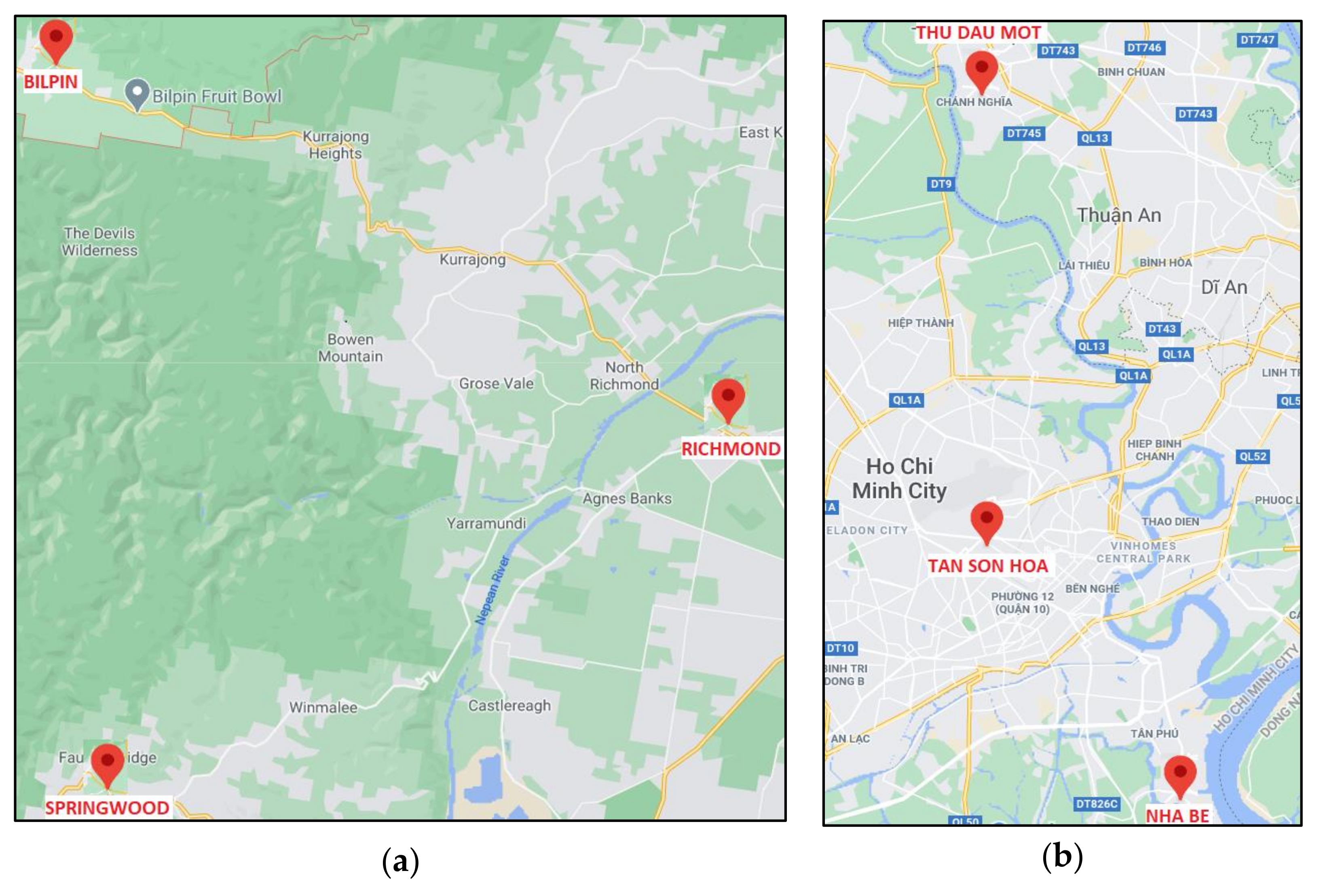
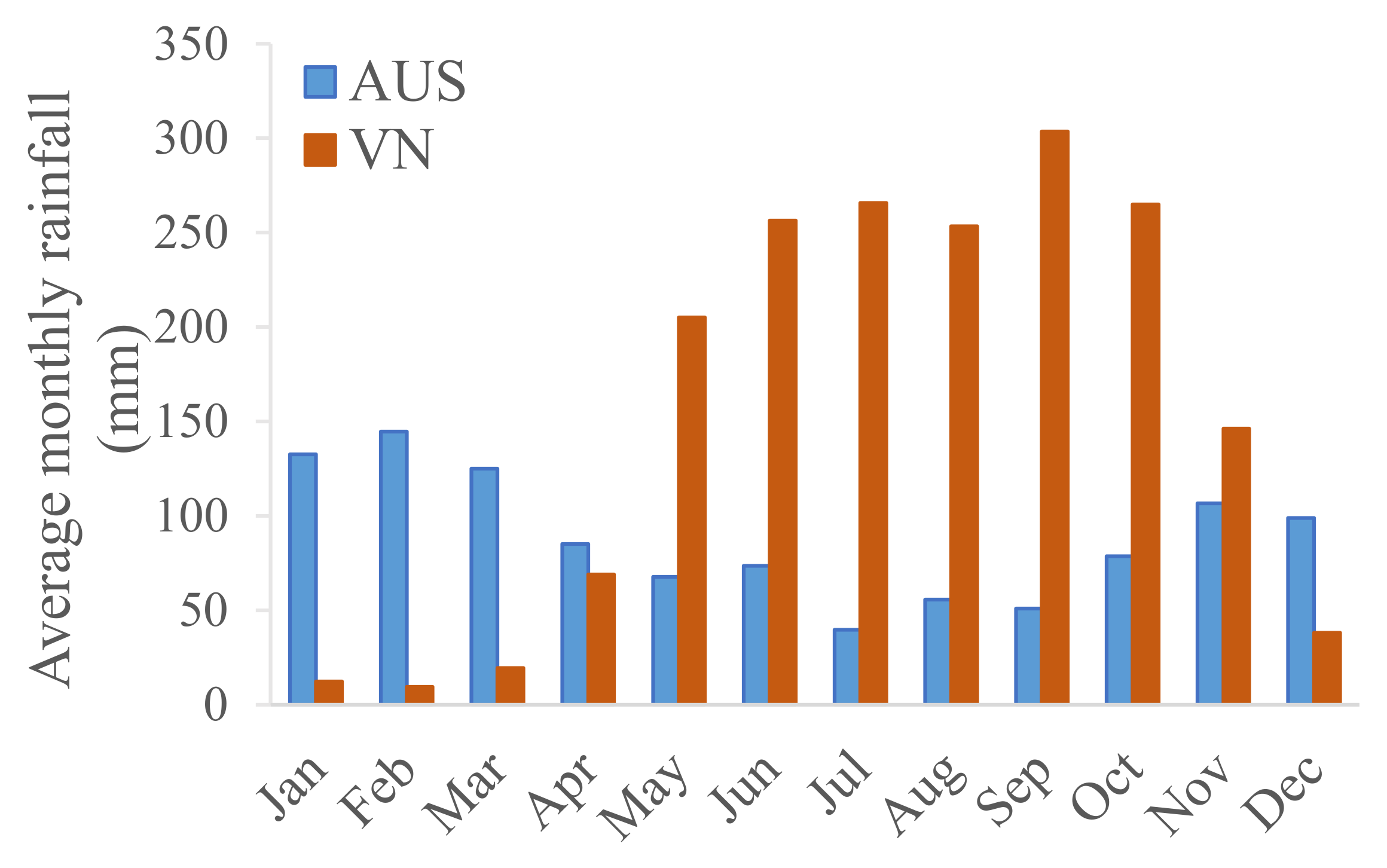
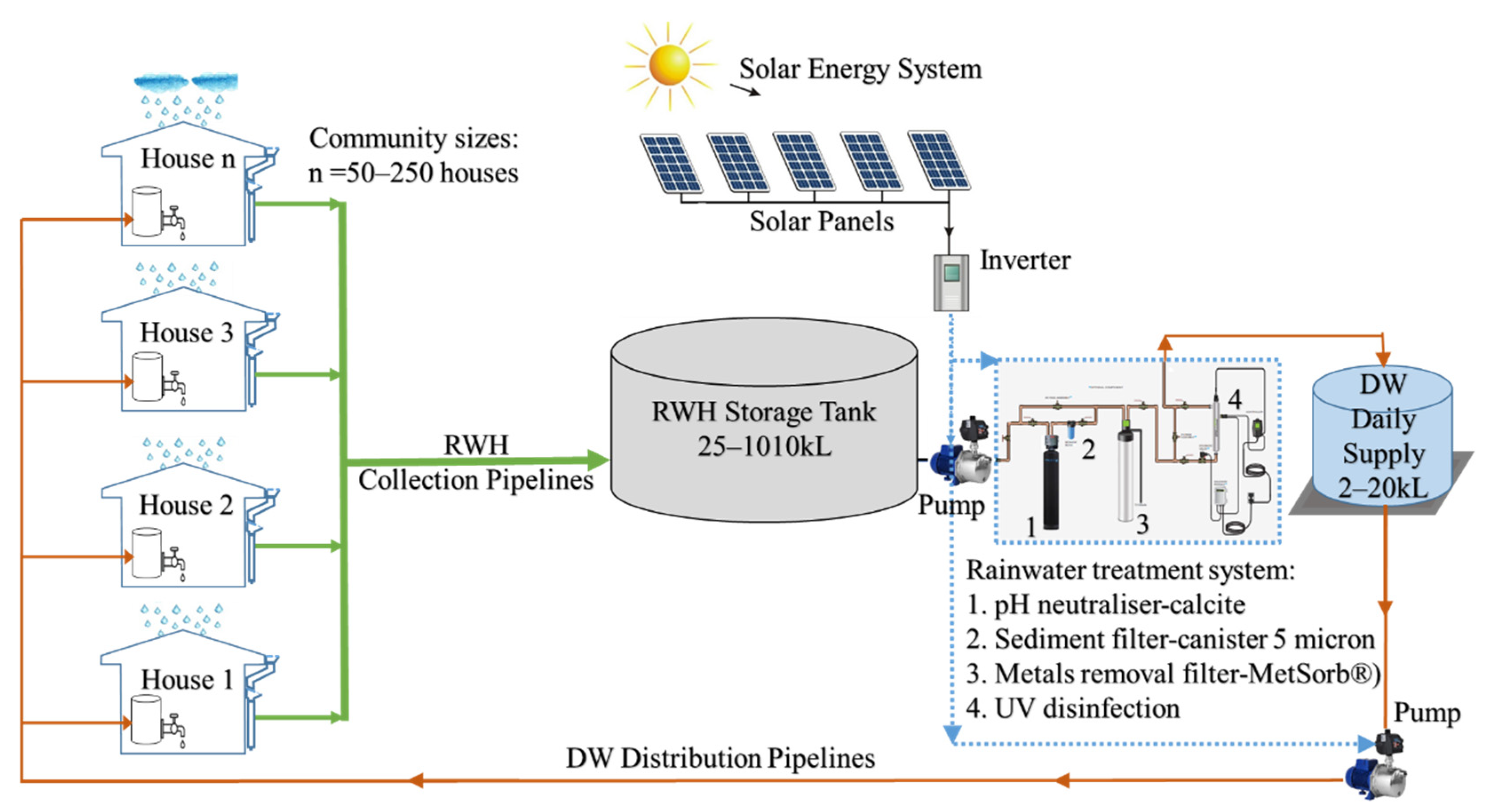

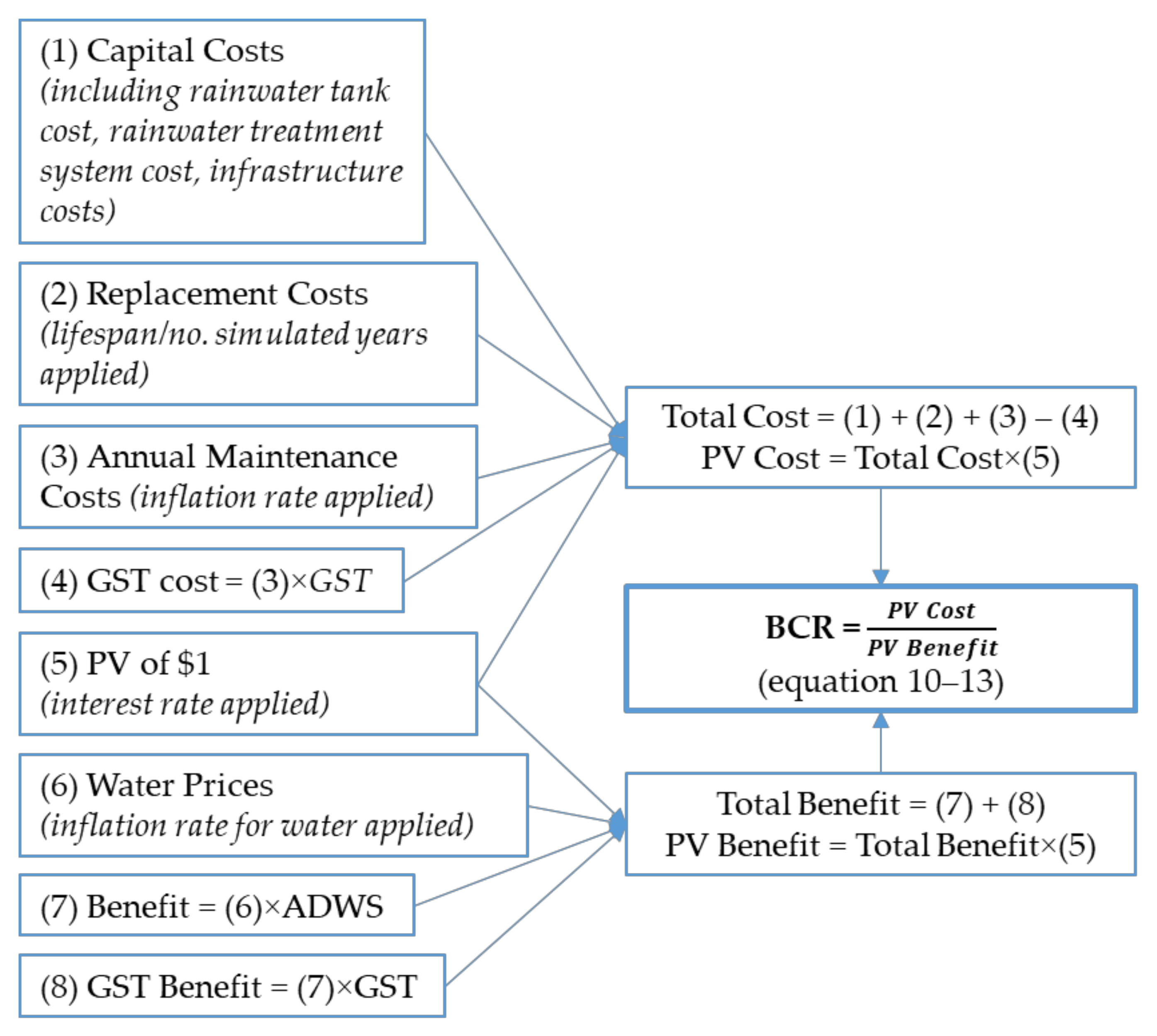


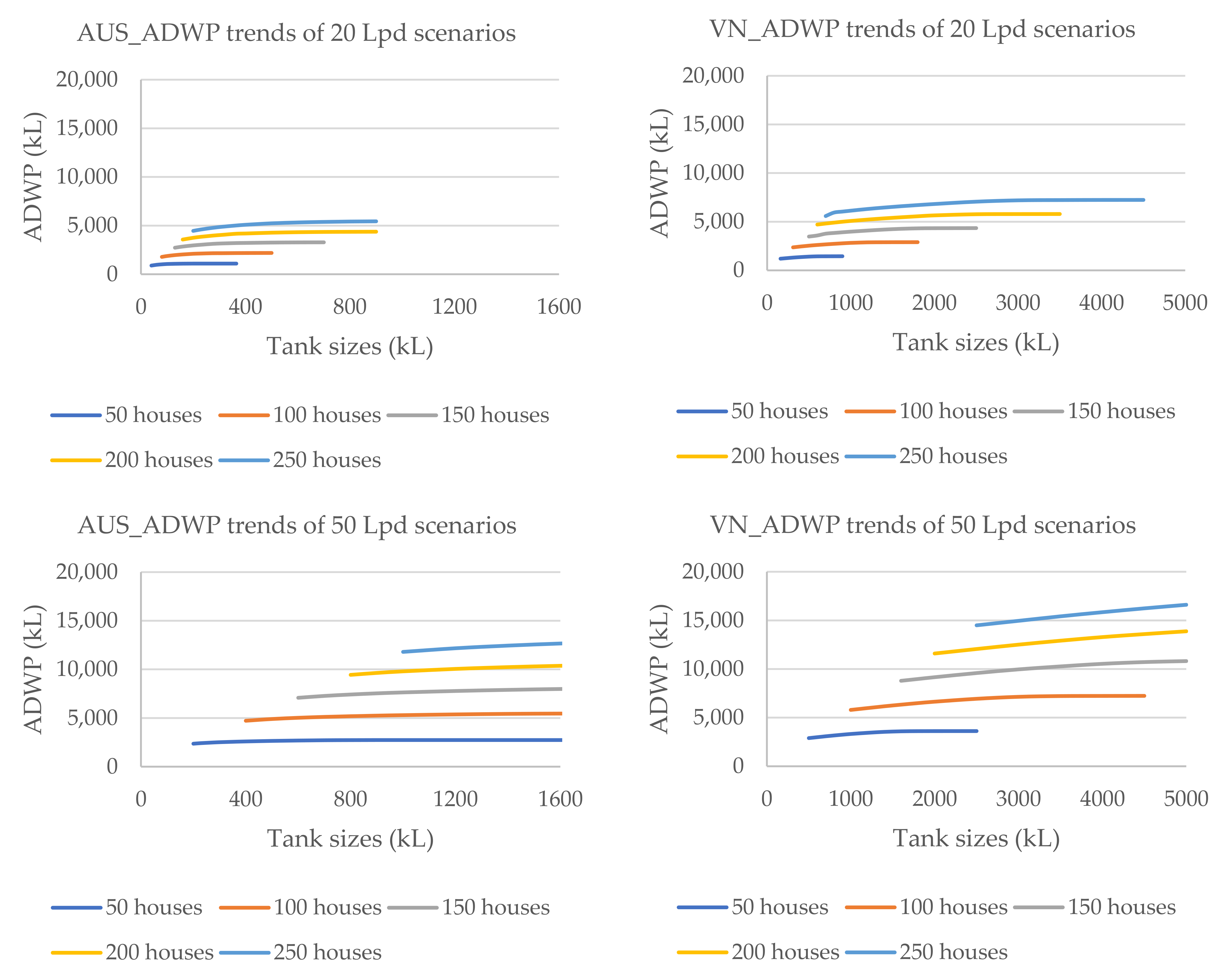
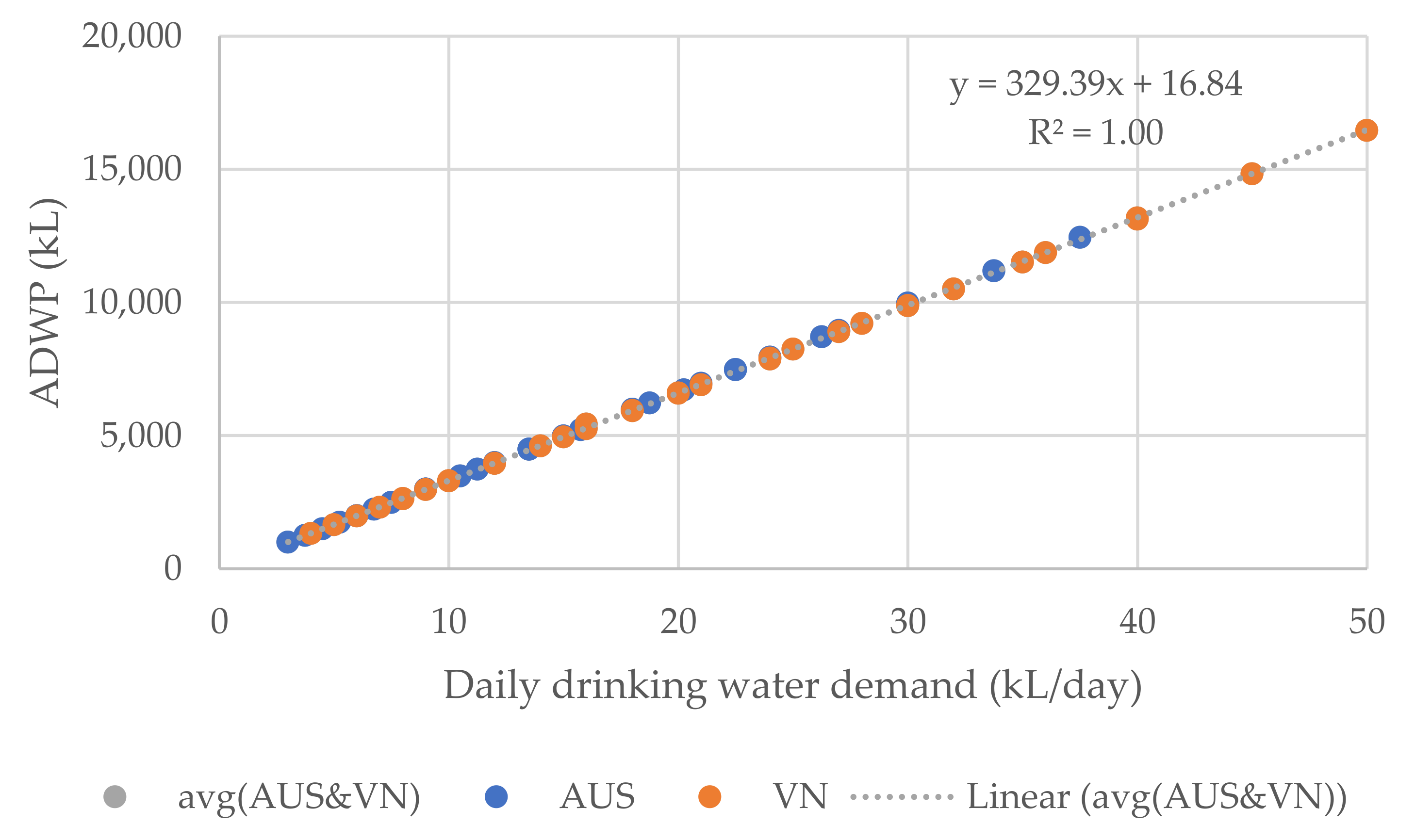
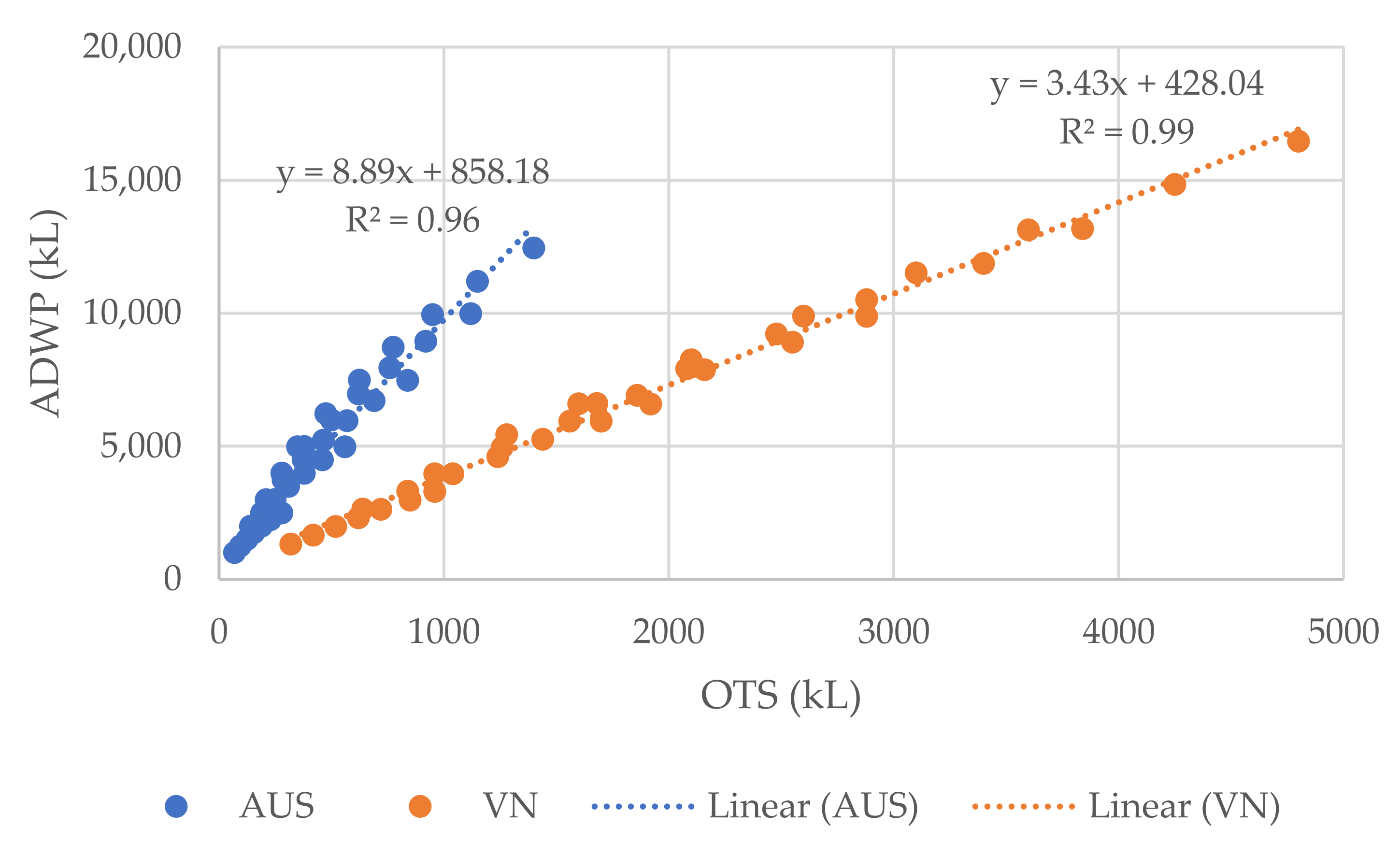
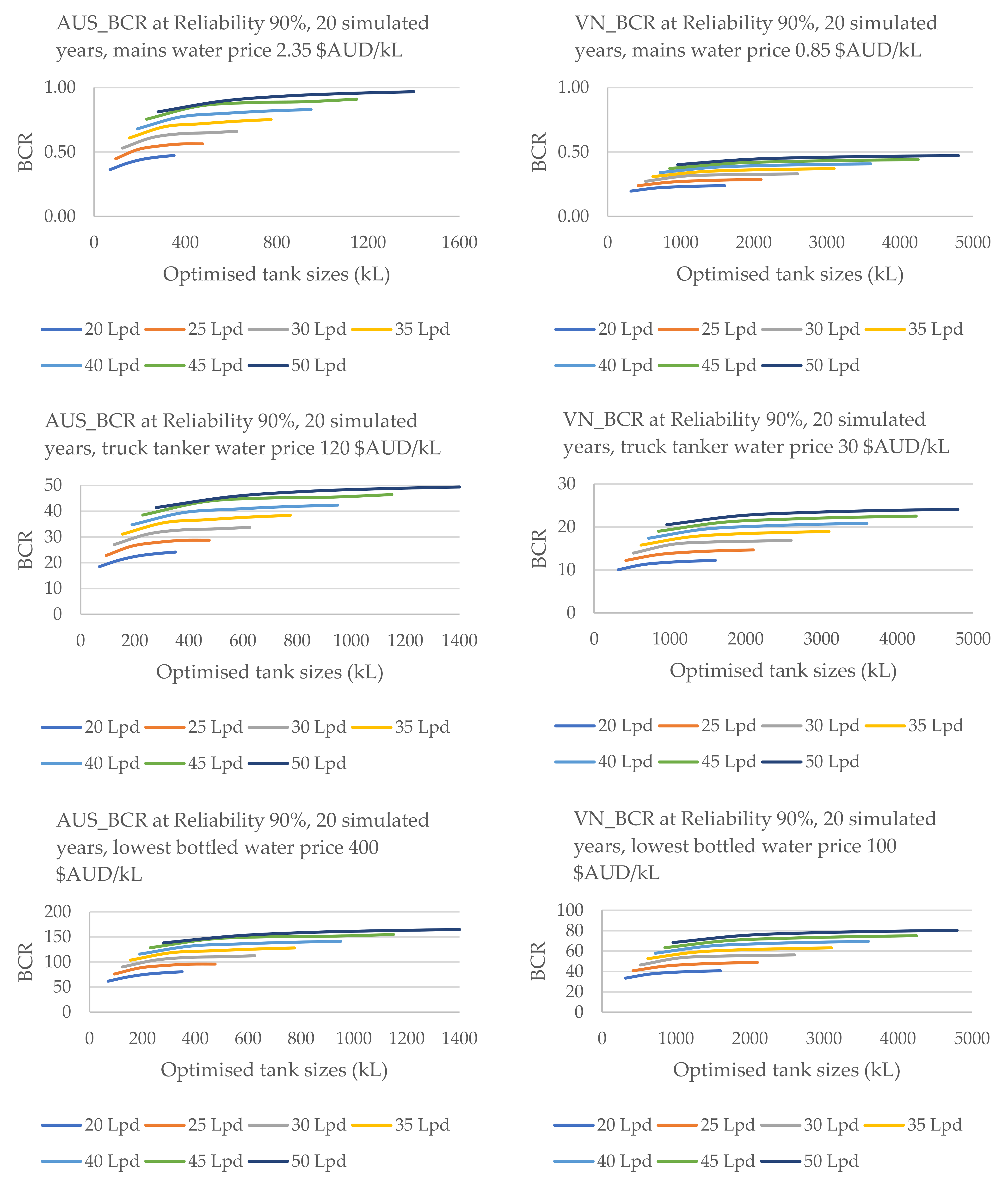
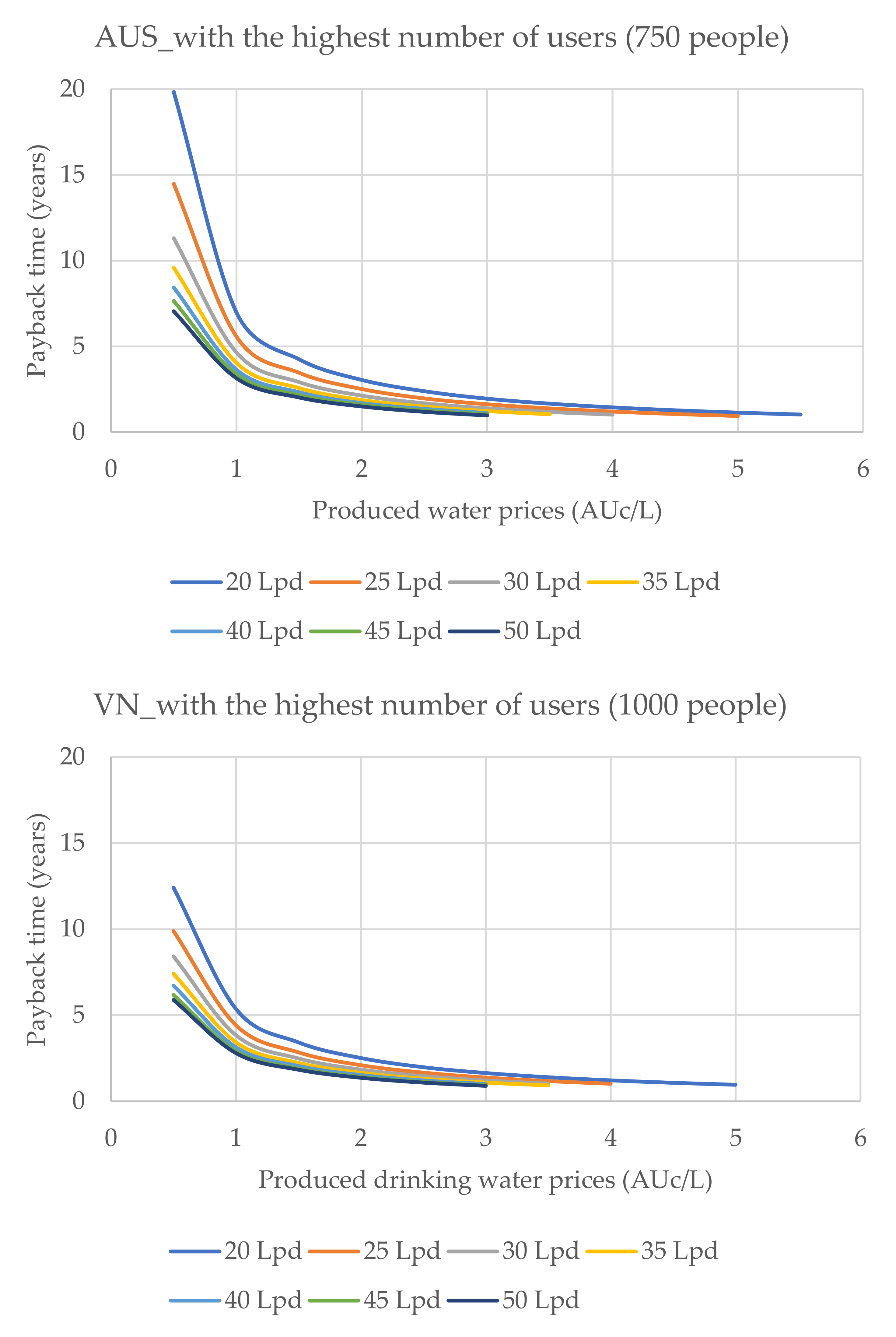
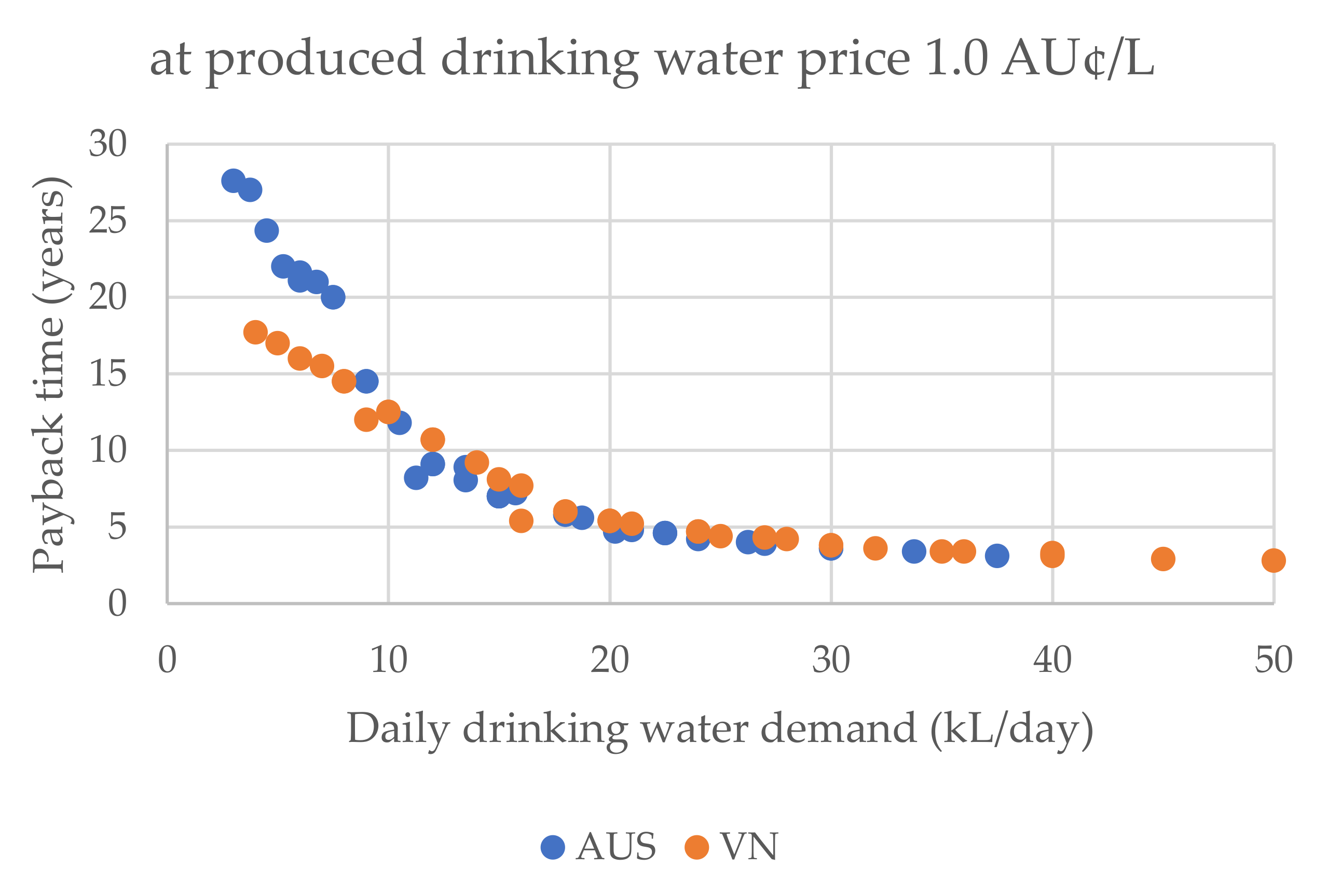
| Countries | Rainfall Stations | Rainfall Record Periods | Annual Rainfall (mm) | Annual Rainy Days | Annual Rainfall (mm) |
|---|---|---|---|---|---|
| Australia | Bilpin | 1960–2019 | 1303 | 133 | |
| Richmond | 1960–2019 | 821 | 119 | 1059 | |
| Springwood | 1960–2019 | 1055 | 108 | ||
| Vietnam | TDM | 1977–2019 | 1891 | 151 | |
| NB | 1980–2019 | 1685 | 140 | 1844 | |
| TSH | 1980–2019 | 1955 | 159 |
Publisher’s Note: MDPI stays neutral with regard to jurisdictional claims in published maps and institutional affiliations. |
© 2022 by the authors. Licensee MDPI, Basel, Switzerland. This article is an open access article distributed under the terms and conditions of the Creative Commons Attribution (CC BY) license (https://creativecommons.org/licenses/by/4.0/).
Share and Cite
Ross, T.T.; Alim, M.A.; Rahman, A. Community-Scale Rural Drinking Water Supply Systems Based on Harvested Rainwater: A Case Study of Australia and Vietnam. Water 2022, 14, 1763. https://doi.org/10.3390/w14111763
Ross TT, Alim MA, Rahman A. Community-Scale Rural Drinking Water Supply Systems Based on Harvested Rainwater: A Case Study of Australia and Vietnam. Water. 2022; 14(11):1763. https://doi.org/10.3390/w14111763
Chicago/Turabian StyleRoss, Tara T., Mohammad A. Alim, and Ataur Rahman. 2022. "Community-Scale Rural Drinking Water Supply Systems Based on Harvested Rainwater: A Case Study of Australia and Vietnam" Water 14, no. 11: 1763. https://doi.org/10.3390/w14111763
APA StyleRoss, T. T., Alim, M. A., & Rahman, A. (2022). Community-Scale Rural Drinking Water Supply Systems Based on Harvested Rainwater: A Case Study of Australia and Vietnam. Water, 14(11), 1763. https://doi.org/10.3390/w14111763








